|

1984 through 1996
The fourth generation of Corvette covers model years 1984 through 1996.
1984
- The all-new Corvette has a drag coefficient (Cd) of 0.34
that's a 24 percent aerodynamic improved over its predecessor.
- The 750,000th Corvette (a 1984 model) is produced at Bowling Green on October 26, 1983.
There were no 1983 Corvettes produced for public sale, No 1983 model is offered. Forty-three "1983" models are produced as pre-production
prototypes of the fourth generation Corvette introduced in April as an '84 model. The 1982 model run continued until October 1982. The Bowling
Green plant then retooled for the 1984 model year. 43 pilot models of the new-generation Corvette were built in 1983 for testing purposes. Only one
of those 1983 pilots is on display at the Corvette Assembly Plant in Bowling Green, Kentucky. The rest were scrapped.
An entirely new Corvette makes its debut in April of 1983 with rave reviews in the media. Compared to the 1982 model, the new car is 1.1 inches
lower, 8.8 inches shorter overall and 2.0 inches shorter in wheelbase. Its wind-tunnel tuned shape carries a drag coefficient of 0.34 24 percent
more aerodynamic than its predecessor. A 5.7-liter V8 provides the power. Interior appointments include a liquid-crystal analog display and digital
instrumentation. The 750,000th Corvette is produced at Bowling Green on October 26, 1983 a white coupe with red interior, in honor of the first Corvette ever built.
1984 featured a double-wishbone front suspension and five-link independent rear suspension teamed with Goodyear Gatorback unidirectional tires.
Inside, the cockpit surrounded the driver and featured advanced electronic instrumentation.The introduction of the 1984 Corvette was one of the
most eagerly awaited vehicle announcements in recent history. It was named Motor Trend,s "Car of The Year."
1985
- Chevrolet introduced the first all-new Corvette since 1968.
- Big news for Corvette is the addition of tuned-port injection on the 230-horsepower 5.7-liter V8.
Big news is made with the addition of tuned-port injection on the 5.7-liter V8. Power is up to 230 hp 19 percent more than the 1984 Crossfire
throttle-body-injected V8. A "Tuned-Port Injection" emblem is added to the fender molding.
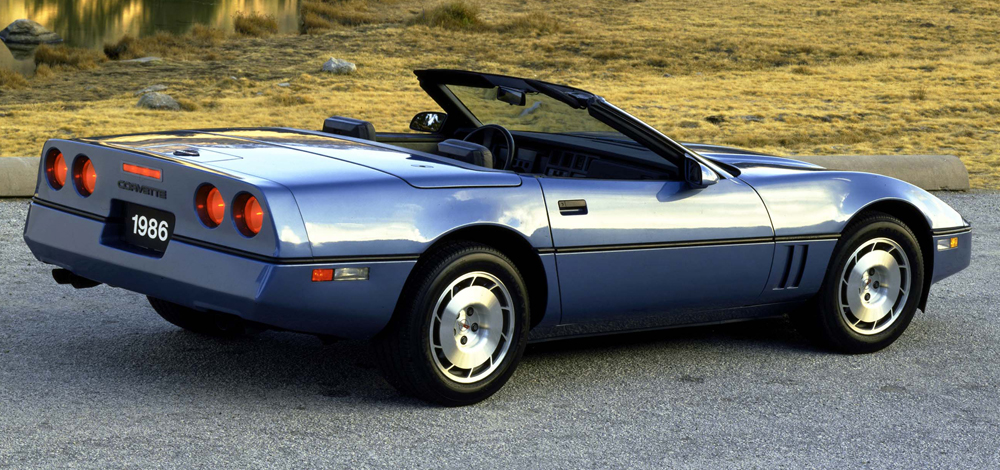
1986
- A convertible model returns to the Corvette line in (after a 10-year absence) and serves as the Indy 500 pace car.
For 1986, the Corvette Convertible returns after a 10-year absence and recaptures Indy-500 pace car duties. Corvette paced the Indy 500 and all
convertibles were designated Pace Car replicas. The evolution of Corvette as a world-class performance car also continued with the addition of new
standard 4-wheel ABS, an increase in maximum horsepower to 230 from its 5.7 Liter V8 and continued suspension fine-tuning. The PASS-Key¨
theft-deterrent system was also added as standard equipment on all models. Bosch 4-wheel Anti-Lock Brake System (ABS) and a sophisticated
Vehicle Anti-Theft System (VATS) that allows the car to start only after the computer reads the correct value embedded in the ignition key are
standard equipment. Federal regulations add a center high mounted stop lamp (CHMSL) to the rear fascia.
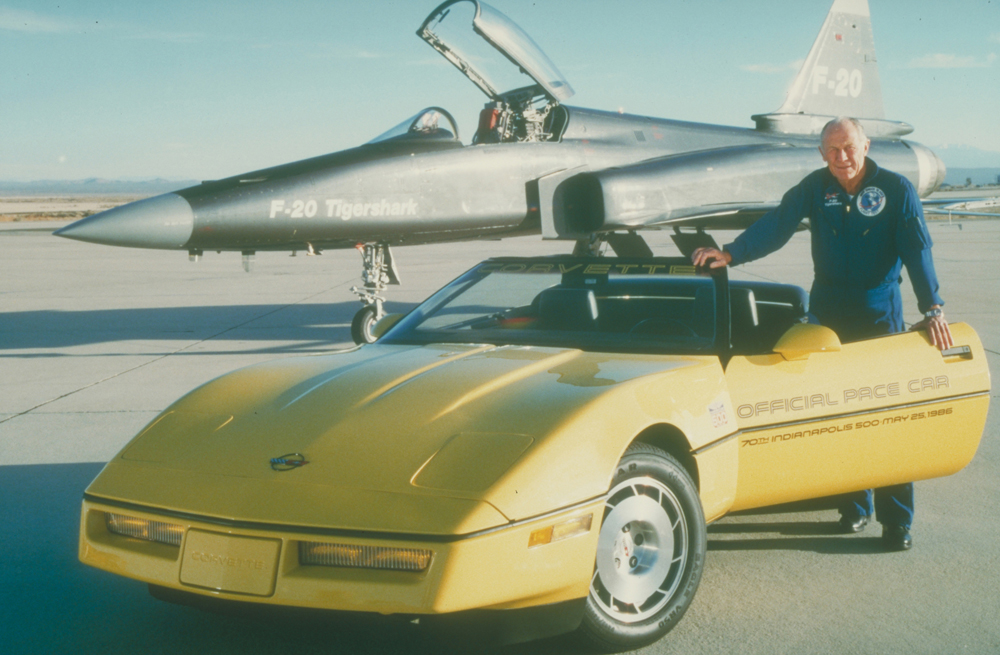
Retired General Chuck Yeager poses with the 1986 C4 Corvette Indy Pace Car he drove for that year's 500 and a military jet.
1987
- A new Z-52 suspension option is available for all-around ride and handling improvements.
A new Z-52 suspension option provides an impressive level of all-around ride and handling for Corvette enthusiasts. Anti-friction, roller-hydraulic
lifters increase fuel economy and horsepower. The popular 6-way power seat adjuster is available for passengers as an option.

1988
- The last Corvette model year for the Doug Nash 4+3 speed manual transmission.
Mechanical changes, new wheels and tires, more standard equipment and new colors highlight the model year. The front suspension is redesigned to
provide a zero-scrub radius, while the rear suspension is revised to improve handling and stability. The combination of new, dual-piston calipers and
larger diameter rotors on the front brakes significantly improves braking and extends pad life. New optional 17 x 9.5-inch wheels are fitted with
Goodyear Eagle ZR-50 tires. The Z-rated rubber carries a 150-mph plus rating. This is the last year of the Doug Nash 4+3 speed manual transmission.
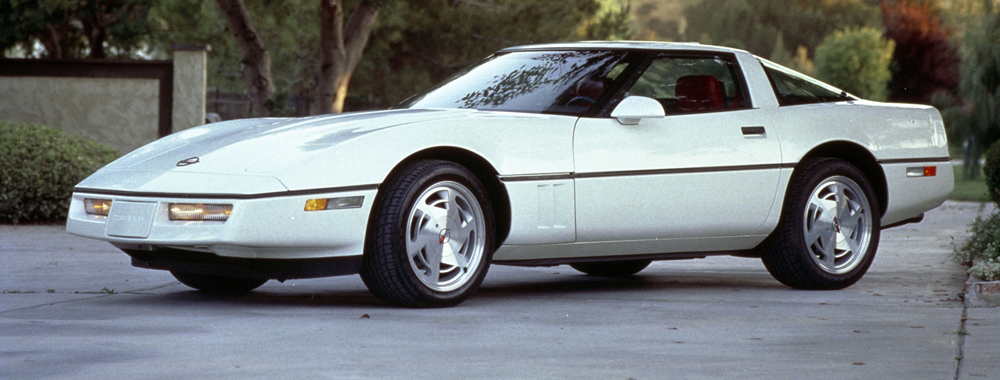
1989
- A new Corvette option is a Selective Ride Control System offering driver selection of three modes - Touring, Sport and Competition.
Corvette handling made great strides in 1989 with the Performance Handling Package becoming standard equipment, along with new 17-inch wheels
and tires. The Selective Ride Control adjustable suspension system was also introduced -- allowing drivers to choose between three different
operating modes: "Touring," "Sport" and "Performance." A new 6-speed manual transmission was also offered, giving drivers added ability to maximize the Corvette power range.
A new ZF 6-speed manual transmission is introduced with a unique computer-aided gear selection (CAGS). An optional Selective Ride Control system
provides three distinctly different ride and handling choices to the driver Touring, Sport and Competition. Seventeen-inch wheels and tires included in '88 with the optional Z52 Sport Handling Package are standard.
1989 Chevrolet Corvette ZR-1; Chevy thunder rolled across Europe in 1989 when 24 pre-production ZR-1 Corvettes arrived on the Continent for a
press tour in the south of France. The ZR-1, also known as the "King of the Hill" Corvette, was powered by a technically advanced 32-valve, 4-cam,
350 cid V8, developed with Group Lotus of England. Although quite tractable at low speeds, the engine coded LT5 had breathtaking performance
right to the red line. Engine supply delays pushed the official ZR-1 introduction into the 1990 model year. The GM Heritage Center has two of the 84
ZR-1s built as 1989 models in its collection. In 2009, Chevrolet resurrected the ZR1 designation (sans hyphen) for a new supercharged Corvette model that surpasses the 1990-1995 ZR-1 in performance.
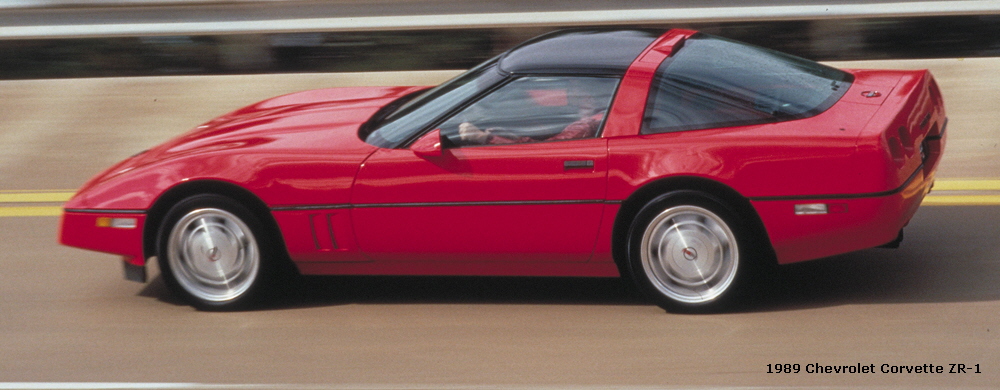
1990
- The Corvette ZR-1 debuts and a driver's-side air bag becomes a standard feature.
ZR-1 roared to life in 1990 with an all-new 375 horsepower LT5 engine under its hood. Designed in a cooperative effort between General Motors and
Lotus, the LT5's dual overhead cam, 32-valve design made Corvette the talk of the automotive world. To help distinguish the appearance of the ZR-1
from standard Corvette Coupes, it was given an all-new convex rear fascia and quad rectangular taillights. All Corvettes received a new cockpit
design that included digital readouts and analog gauges as well as a driver air bag. The maximum horsepower of the standard L98 engine was increased to 250.
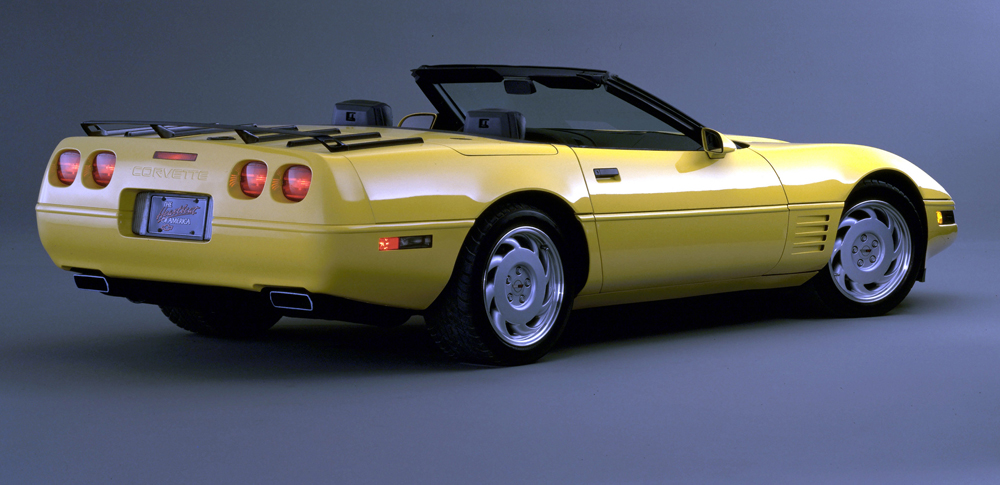
1991
- The first major restyle since 1984 adds ZR-1-type exterior appointments to the Coupe and Convertible.
The first major restyle since 1984 adds ZR-1-type exterior appointments to the coupe and convertible. Also featured: New side "gills;" wider,
body-color side moldings; updated emblems; and relocated center high-mounted stop lamp (to the rear fascia). A new Z07 high-performance
suspension option for race track use is offered. The Selective Ride Control System (RPO FX3) is available on the convertible for the first time.
1992
- Performance of the new 300-horsepower 5.7-liter V8 engine is so impressive that it's given the legendary LT1 designation.
Corvette performance continued to grow in 1992 with the introduction of the second-generation LT1 -- putting a 300-horsepower engine back in the
standard Corvette. The engine was designated LT1 because it was the first Chevy "Small Block" to surpass the horsepower of the original LT1 in
1970. The Acceleration Slip Regulation (ASR) system and Goodyear GS-C asymmetrical tires were also introduced as standard equipment. ZR-1 received a ZR-1 badge on the sides of its clam shell hood.
The one-millionth Corvette was built on July 2, 1992 in Bowling Green, Kentucky. The one-millionth Corvette - a white convertible with red interior,
matching the first Corvette - rolls off the Bowling Green assembly line on July 2, 1992.
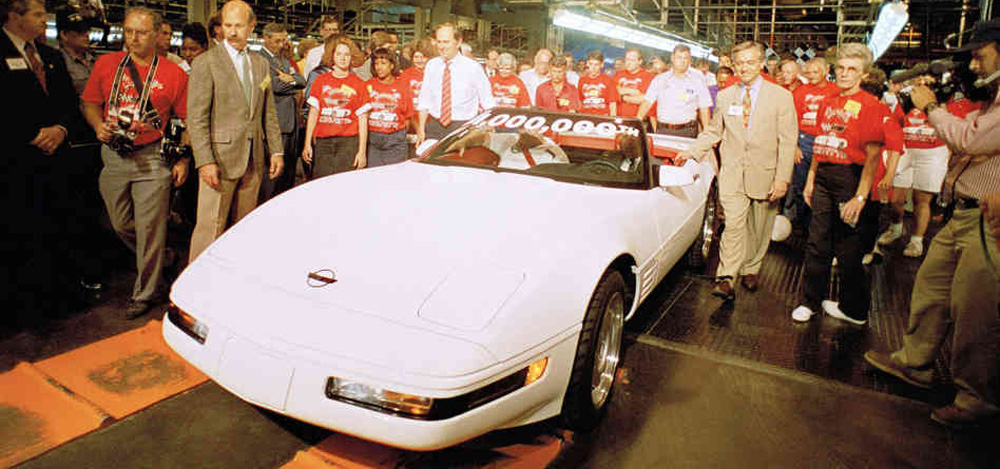

1993
- A special 40th Anniversary Edition featuring 'Ruby Red' exterior paint is offered on Coupes and Convertibles.
For 1993, LT5 output was boosted to 405 horsepower, and a special 40th Anniversary package was available on all models. Passive Keyless Entry (PKE) was also added as standard equipment..
Corvette celebrates its 40th birthday on June 30, 1993, and a special 40th Anniversary version is offered on both coupe and convertible. It features
an exclusive "ruby red" exterior and interior with color-keyed wheel centers, headrest embroidery and bright emblems on the hood, deck and
side-gills. Improved breathing increases ZR-1 to 405 hp, up 30 hp over 1992. Continuing Corvette's tradition of offering leading-edge technology, the
1993 model introduces GM's first Passive Keyless Entry System (PKE). Simply approaching or leaving the Corvette automatically unlocks or locks the
appropriate doors. Ride and handling is improved through slightly smaller front wheels.
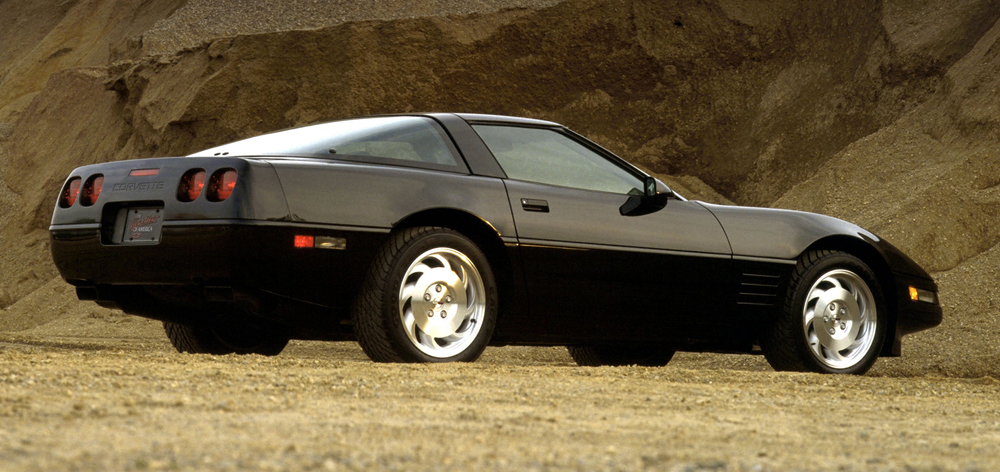
1994
- New standard features include a passenger's-side air bag and introduction of Sequential Fuel Injection.
The cockpit of Corvette was transformed for 1994 with a new single-piece instrument panel, a front-passenger air bag, and new door panels. Both
the standard and Sport seats were also restyled, and leather seats became standard equipment.
With the addition of a passenger-side air bag, Corvette now has dual air bags. Sequential fuel injection for the 5.7-liter V8 (LT1) engine provides a
smoother idle, better performance and lower emissions. The LT1 engine receives a new automatic transmission the 4L60-E electronic four-speed
with overdrive. The transmission has been revised for a more consistent shift feel even with significant changes in altitude. A brake-transmission shift
interlock feature requires the brake pedal to be depressed before shifting from "Park."
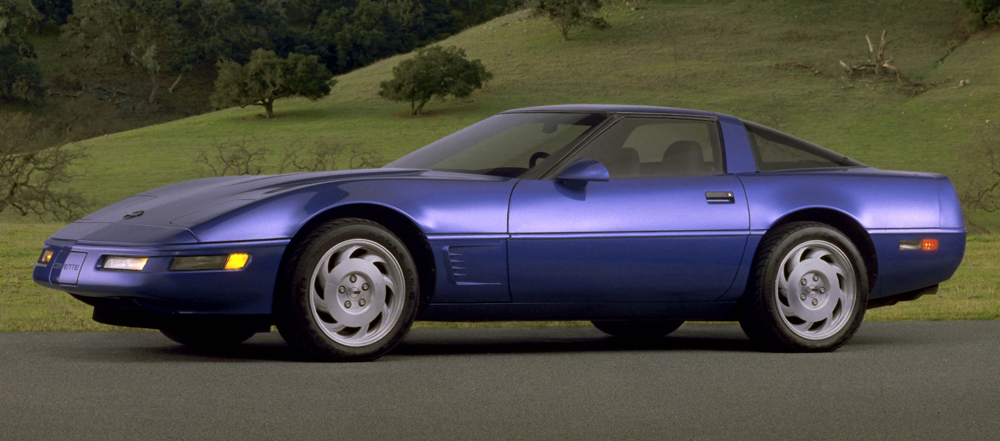
1995
- The final year of ZR-1 production; also the third time that a Corvette paces the Indy 500.
The most noticeable change on the 1995 Corvette was the revised gill panel design. This also marked the last year for the ZR-1. Corvette is selected
as the Indianapolis 500 Pace Car for the third time. Jim Perkins drives the Indy Pace Car at this year's race. Chevrolet commemorates the event with
an Indy Pace Car replica a two-tone, purple and white convertible. Only 527 are built, making it the rarest of the three Corvette pace car replicas. 1996 Corvette Collector Edition.
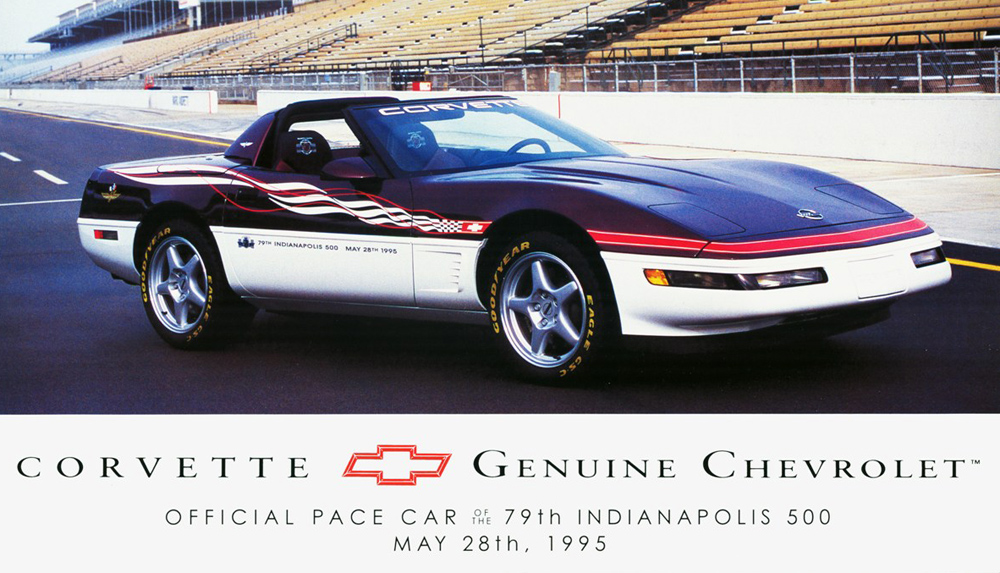
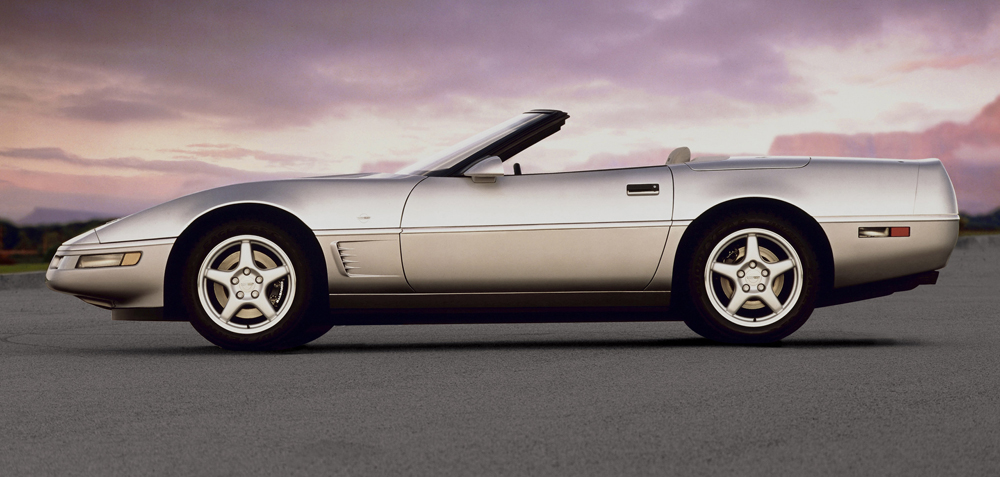
1996
- Two unique Corvette models become available - a 'Collector Edition' and a 'Grand Sport.'
Corvette celebrates the final year of the fourth generation by offering a 1996 Collector Edition Corvette. The '96 Collector Edition includes Sebring
Silver paint, special trim and 17-inch, ZR-1 style wheels. Chevrolet also produces the Corvette Grand Sport, in honor of the '60s racers of the same
name. The Grand Sport is identified by Admiral Blue paint, a white center stripe, and red hash marks on the left front fender. Also, '96 is the only year
for the optional LT4 5.7-liter V8 engine, featuring a higher compression ratio and 30 more horsepower than the base LT1.
1996 CORVETTE: TWO SPECIAL EDITIONS AND NEW 330-HP LT4 V8 HIGHLIGHT AMERICA'S FAVORITE SPORTS CAR
Two very special Corvettes - the Grand Sport and Collector Edition - will add to the marque's legendary mystique. A new optional 330-horsepower 5.7
Liter LT4 engine, available on all Corvette models, raises the revered small block's performance level to a sensational new height.
The return of the Grand Sport evokes memories of the five special lightweight Corvette race cars constructed from 1962-63 under the direction of
Zora Arkus-Duntov. This handful of ultralight machines - three coupes and two roadsters - became the most recognizable Corvette race cars of that
era. With their special tubular frames, thin fiberglass skins, wheel flares, louvered hoods, and all-aluminum 377-cu.-in. small block engines, the Grand
Sport earned a place in Corvette history. Legendary racers such as Roger Penske, Jim Hall, Dick Guldstrand, Dick Thompson, Augie Pabst and A. J. Foyt drove the Grand Sport in competition.
The 1996 version of the Grand Sport evokes memories of its predecessors with its exclusive Admiral Blue Metallic paint, white stripe, and red "hash
marks" on the left front fender. Chromed "Corvette" emblems on hood and fuel door, 17" five-spoke black aluminum wheels, black brake calipers with
raised bright aluminum "Corvette" lettering, and perforated Sport bucket seats available in Red/Black combination or Black options with emroidered
"Grand Sport", distinguish the Grand Sport for 1996. Grand Sport Coupes are outfitted with P275/40ZR- 17 (front) and P315/35ZR-17 (rear) tires, and
special rear fender flares cover the extra-wide rear rubber. Convertibles roll on P255/45ZR-17 (front) and P285/40ZR-17 (rear) tires. There will be limited production for Grand Sport models, each carrying a unique serial number.
The 1996 Corvette Grand Sport has the horsepower to support its racing heritage. A new 330-horsepower LT4 small block V8 is standard on Grand
Sport (optional on all other Corvette models). A further development of the powertrain technology introduced on the LT1 V8 for 1992, the muscular
new LT4 has the performance advantages of high-flow aluminum cylinder heads, larger hollow-stem valves and higher load springs, a more aggressive
camshaft profile, revised pistons with a 10.8:1 compression ratio, a new fuel injector that increases fuel flow, and friction-reducing roller rocker arms.
The LT4 engine assembly is bolstered with an undercut and rolled fillet cast iron crankshaft, steel camshaft and water pump gears driven by a roller chain and premium head gaskets.
The LT4 stands out from its small block siblings with unique appearance features, including a red inlet manifold, red spark plug and coil wires, red
"Corvette" lettering on the manifold covers and red "Grand Sport" lettering on the throttle-body cover. Models equipped with the LT4 engine have an
8000-rpm tachometer with a 6300-rpm redline. The High Output LT4 is available only with a 6-speed manual transmission.
The new "Collector Edition" model celebrates the final year of production for the fourth-generation Corvette. This eminently collectible Corvette model
is distinguished by its exclusive Sebring Silver paint, chromed "Collector Edition" emblems, 17" five-spoke aluminum wheels painted silver,
P255/45ZR-17 (front) and P285/40ZR-17 (rear) tires, and black brake calipers with raised bright aluminum "Corvette" lettering. The cockpit-style
interior features perforated Sport seats with "Collector Edition" embroidery available in Torch Red, Black or Light Gray. Coupe and Convertible Collector
Edition models are available with either the standard 300-horsepower 5.7 Liter LT1 V8 (with 4-speed electronically controlled automatic overdrive
transmission) or the optional 330-horsepower LT4 (with 6-speed manual transmission).
1996 also marks the introduction of a new Selective Real Time Damping system, which is optional on all Corvette models. Selective Real Time Damping
employs sensors at each wheel, to measure movement. The data retrieved from each individual wheel and the PCM (Powertrain Control Module) are
processed by a special electronic controller which calculates the damping mode that will provide optimum control of the vehicle. This sophisticated
driver-adjustable Delco ride control system adjusts the shock absorbers in "real time" - 10 to 15 milliseconds.
A new optional Z51 Performance Handling Package, available exclusively on Corvette Coupe, is tuned for the autocross and gymkhana enthusiasts.
The package features Sport Suspension ride and handling, new Bilstein shock absorbers, stiffer springs, front and rear stabilizer bars, high-rate
bushings, 17" x 9.5" wheels, and P275/40ZR-17/N tires. (Grand Sports have 17" x 11" wheels and P315/35ZR-17 tires in the rear.)
Corvette has long been a showcase for leading-edge technology. Its sophisticated standard systems include Passive Keyless Entry (PKE), PASS-Key
II theft-deterrent system, and Bosch ABS/ASR anti-lock braking and Acceleration Slip regulation. Goodyear Extended Mobility Tires (EMT) which
permit the vehicle to be operated with out air at 55 mph for up to 200 miles, as well as a low-tire-pressure warning system are available on Corvette
Coupe and Convertible. Corvettes equipped with EMT tires can be ordered without a spare tire.
Corvette has a lengthy list of standard equipment, including dual air bags, 4-wheel independent suspension, 4-wheel anti-lock disc brakes, power
windows with driver's Express-Down and door locks, dual electric heated outside rearview mirrors, cruise control, rear-window defogger, 17-inch aluminum wheels and high-performance Goodyear Eagle GS-C tires.
Corvette isn't just an automobile - it's an American institution. Corvette doesn't simply compete in the sports car market, it defines it. With two new
special edition models and a more powerful small block V8 option, Corvette continues its reign as America's favorite sports car.
The 1996 Corvette lineup includes two models:
- Corvette Coupe: 2-door coupe
- Corvette Convertible: 2-door convertible Collector Edition (Z15)
A new "Collector Edition" model celebrates the final year of production of the fourth-generation Corvette. This collectible Corvette has the following features:
- Exclusive Sebring Silver paint
- Available in Coupe or Convertible (Convertible withblack top only)
- Chromed "Collector Edition" emblems on wheels,front fenders, hood, and fuel-filler door
- Available with standard 300-horsepower LT1 (withautomatic transmission only) or optional 330 horse-power LT4 (with 6-speed manual transmission only)
- Black brake calipers with raised bright aluminum "Corvette" lettering
- Aluminum five-spoke 17"-diameter wheels painted silver
- P255/45ZR-17 front and P285/40ZR-17 rear tires
- Perforated Sport seats with "Collector Edition" embroidery
- Torch Red, Black, or Gray interior.
- Grand Sport (Z16)
A new "Grand Sport" model reminds Corvette afficionados of the legendary lightweight Corvette road racers of the '60s and delivers the advanced
technology of the '90s. With a limited production run, all Corvette Grand Sport models include the following:
- Standard 330-horsepower LT4 engine and 6-speedmanual transmission (automatic not available)
- Available on Coupe or Convertible (Convertible with white top only)
- Exclusive Admiral Blue Metallic paint with center white stripe and red "hash marks" on left front fender
- Chromed "Corvette" emblems on hood and fuel-filler door
- "Grand Sport" emblems on the front fenders
- Rear-wheel flares
- Black brake calipers with raised bright aluminum "Corvette" lettering
- Black five-spoke 17"-diameter Aluminum wheels
- Coupe and Convertible: P255/45ZR-17 (front) and P285/40ZR-17 (rear) tires
- Perforated Sport seats with "Grand Sport" embroidery
- Red/black or Black interior colors
- Unique serial numbers.
1996 Corvette - Engines (LT1)
The 5.7 Liter LT1 small block V8 is the standard powerplant for Impala SS, Camaro Z28 Coupe, Z28 Convertible, Caprice Wagon and Corvette, and optional on Caprice Classic Sedan.
It produces 300 hp @ 5000 rpm, 285 hp @ 5200 rpm and 260 hp @ 5000 rpm for Corvette, Camaro and Caprice respectively. It produces 335 lb.-ft.
torque at 4000 rpm, 325 lb.-ft. @ 2400 rpm and 330 lb.-ft. @ 2400 for Corvette, Camaro and OBD II (On-Board Diagnostics Second Generation) is standard.
The LT1 V8 is improved for 1996:
Exhaust manifolds have tri-layered stainless-steel exhaust gaskets which improve durability and reduce exhaust leaks
Recyclable copper-lead cam bearings replace the cadmium lead bearings used previously
Low-resistance ignition wires and platinum-tip spark plugs are designed to improve idle quality and cold-start performance
Revised pistons use a new positive-twist top ring that improves the piston-to-cylinder seal and reduces blow by emissions at high engine speeds.
The Powertrain Control Module (PCM) monitors the emissions system and its components to detect deterioration or malfunction. It also controls
individual fuel injectors, optical ignition system and interacts with the available electronically controlled transmission. See OBD II section for details.
Introduced in the 1992 Corvette, the second-generation 5.7 Liter LT1 V8 packs impressive performance and responsiveness into an efficient package.
The LT1's operating range extends hundreds of rpm beyond most OHV engines, giving the LT1 the low-speed punch of a traditional pushrod engine
and the high-speed performance of an OHC design. This "best of both worlds" character makes the LT1 derived engine a potent powerplant for the
full-size Impala SS, Caprice Classic and Camaro Z28 models. The LT1 combines outstanding efficiency, emissions compliance, durability, and performance.
Numerous technical features contribute to the LT1's outstanding performance:
Sequential Fuel Injection (SFI) optimizes combustion by using input from the PCM to precisely match fuel delivery to each cylinder's intake stroke. SFI
is designed to provide a smooth idle, impressive driveability and precise emissions control
A mass airflow sensor provides accurate information on the amount of air entering the engine, which the Powertrain Control Module uses to determine the fuel requirement for maximum efficiency.
A low-restriction intake and air filtration system lets the engine breathe freely for efficiency, while meeting federal noise regulations
The LT1's cylinder head porting -- coupled with a weight-saving, one-piece intake system -- is designed to improve airflow into the combustion chambers for cleaner, more controlled burning, which can enhance power and efficiency
A reverse-flow cooling system circulates coolant through the cylinder heads before the engine block, improving heat transfer in the engine and radiator, and allowing a higher compression ratio for increased power
A gear-driven coolant pump virtually eliminates side-load stresses and ensures an uninterrupted coolant flow, even in the event of accessory belt breakage
An oil change monitor calculates and displays the condition of the engine oil from inputs such as miles driven, ambient air temperature and oil temperature
A standard oil-level sensor alerts the driver to a low-engine-oil condition when only one or two quarts are needed, instead of when the crankcase is virtually dry and engine damage is imminent.
Upgraded oil pan
Composite rocker-arm covers added to absorb engine noise and vibration
1996 Corvette - Engines (LT4)
A new High Output 5.7 Liter SFI V8 is available exclusively in Corvette Coupe and Convertible for 1996. Based on the famous LT1 small block, the new
LT4 produces 330 horsepower at 5800 rpm (an increase of 30 horsepower over the LT1) and 340 lb.-ft. of torque at 4500 rpm. OBD II (On-Board
Diagnostics Second Generation) is standard. The LT4 is the standard (and only) engine available on the new Grand Sport model. The LT4 is optional
on the new Collector Edition, Coupe and Convertible models. This ultra-high-performance engine is available only with a 6-speed manual transmission.
The LT4 stands out with unique appearance features:
- Red inlet manifold
- Red spark plug and coil wires
- Red "Corvette" lettering on manifold covers
- Red "Grand Sport" lettering on throttle-body cover.
- The following features contribute to the LT4's outstanding performance compared to the LT1:
- Aluminum cylinder heads with revised combustion chambers and ports increase airflow
- Large 2.00" intake valves and 1.55" exhaust valves (versus 1.94"/1.50" valves in LT1) improve breathing
- Lightweight hollow valve stems reduce valve train mass and increase rpm potential
- High-load valve springs improve valve train dynamics at high rpm
- Revised piston design with reduced valve pocket depth produces 10.8:1 compression ratio (versus 10.4:1 in LT1)
- Aggressive camshaft profile has increased valve lift and overlap for high rpm operation for improved performance at high rpm
- High-capacity fuel injectors meet LT4's increased fuel flow needs for higher performance
- Roller rocker arms reduce internal friction
- Exhaust manifold features single-point air injection and electric air pump to eliminate the parasitic loss inherent in mechanical systems.
- Undercut and rolled fillet cast iron crankshaft improves durability
- Opti-Spark provides one of the highest precision spark control and delivery system available
- Dual-mass front torsional damper is tuned for high engine speeds
- Premium head gaskets provide reliable sealing with high cylinder pressures
- Steel cam drive and water pump gears driven by a roller chain enhance durability
- Teflon rear crankshaft seal improves durability.
1996 Corvette - Transmissions (6-Speed Manual)
A ZF 6-speed manual transmission is standard on all 1996 Corvette models equipped with a 5.7 Liter LT4 engine -- Grand Sport, Collector Edition,
Coupe and Convertible. (The 6-speed is not available with the 5.7 Liter LT1 engine for 1996.)
Introduced in 1989, the 6-speed gearbox was designed specifically for the Corvette by Zahradfabrik Friedshafen A.G. (ZF), a German transmission manufacturer known worldwide for its transmission expertise.
The 6-speed's 2.68:1 ratio in first gear provides high torque multiplication, for quick initial acceleration; two overdrive gears (0.75:1 fifth and 0.50:1
sixth) produce quiet, economical highway cruising. All speed-equipped Corvettes have a 3.45:1 rear axle ratio.
The 6-speed incorporates a Computer-Aided Gear Selection (CAGS) system. The CAGS system is designed to improve fuel economy during normal
driving situations by directing the driver from first gear to fourth gear under light acceleration from a dead stop. Rapid acceleration automatically cancels the one-to-four shift.
4-Speed Automatic Overdrive Transmission (4L60-E)
The Hydra-matic 4L60-E 4-speed automatic overdrive transmission is standard equipment on all Caprice Classic, Impala SS and Corvette models
equipped with LT1 engine, and is available on all Camaro models. The 4L60-E's "intelligent" electronic controls allow the transmission to match the engine's performance.
The 4L60-E has been refined for 1996. These refinements include:
- Pulse width-modulated solenoid has been replaced with a simple on-off solenoid to help maintain shift quality
- Premium friction material is used for the intermediate clutch and front and rear bands
- The 4L60-E's 298-mm torque converter features specially brazed turbine pump blades designed to reduce fluid leakage, increase efficiency and improve durability
- A new torque management strategy protects the powertrain by reducing the amount of energy and heat generated by frequent severe shifts
when a vehicle stuck in a snow bank or similar situation is "rocked." The 4L60-E's wide range of gear ratios enhances both performance and
economy. The 3.06:1 first-gear ratio provides high torque multiplication, for initial acceleration. The overdrive 0.70:1 fourth gear reduces engine rpm at cruising speed, thereby reducing wear.
- The 4L60-E provides the precision and flexibility of electronic controls. Shift points and shift smoothness are controlled by four solenoids that are connected to the Powertrain Control Module (PCM).
- The PCM acts as an interface between the engine and transmission, to provide the feel of a virtually "seamless" powertrain
- The PCM monitors engine and transmission performance several times a second to ensure smooth gear changes and proper shift points
- The 4L60-E senses and adapts to changes in altitude, barometric pressure and engine load, for maximum efficiency
- The refined torque-converter-clutch controls provide nearly imperceptible clutch application and release
- Electronic controls provide the security of "fail-safe" operation; if the controls malfunction for any reason, the transmission will automatically
default to operable gear ratios, enabling the driver to reach a safe location.
- The 4L60-E's second-gear-start feature provides an extra measure of control in hazardous driving conditions. By moving the gear selector to
the D2 position, the driver can reduce torque to the drive wheels, increasing control during initial acceleration on slippery surfaces.
- 4L60-E transmissions are factory-filled with long-life Dexron III automatic transmission fluid that never needs replacement under normal driving conditions.
|












